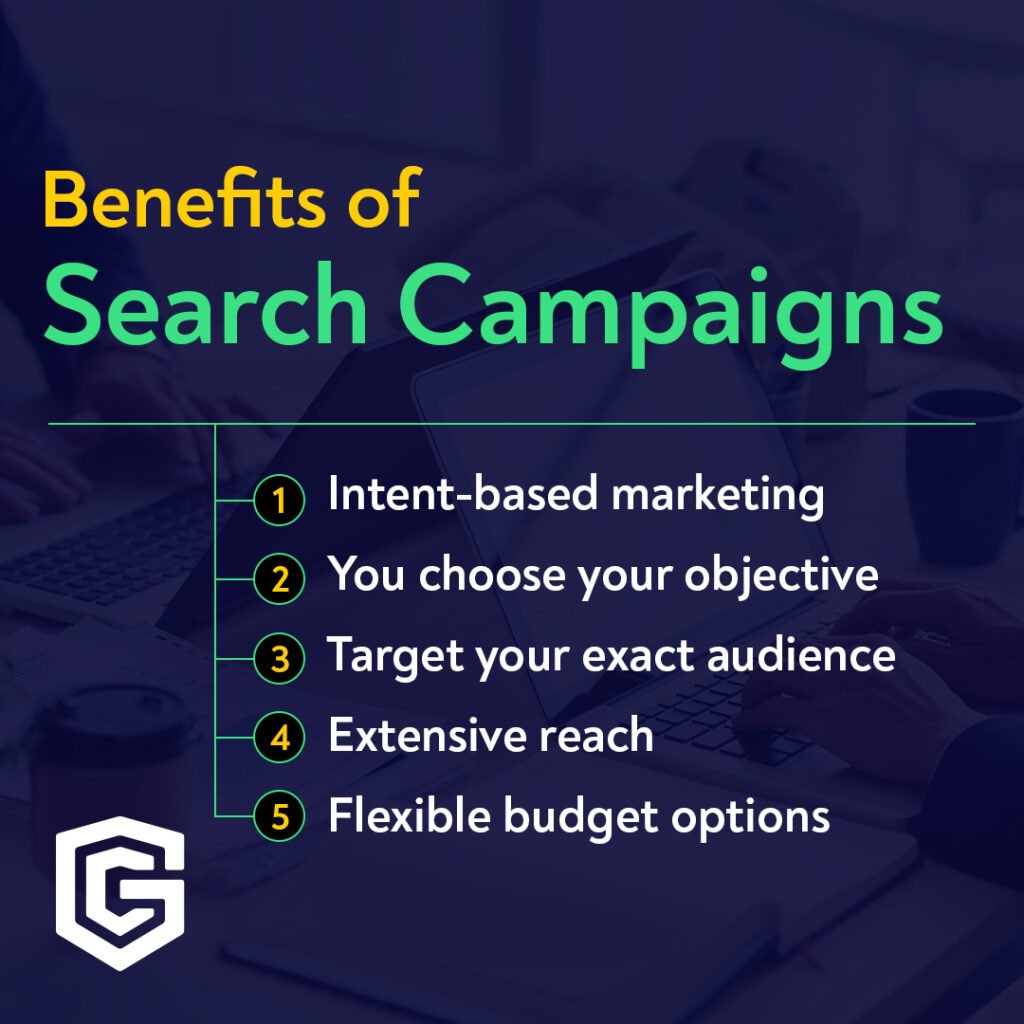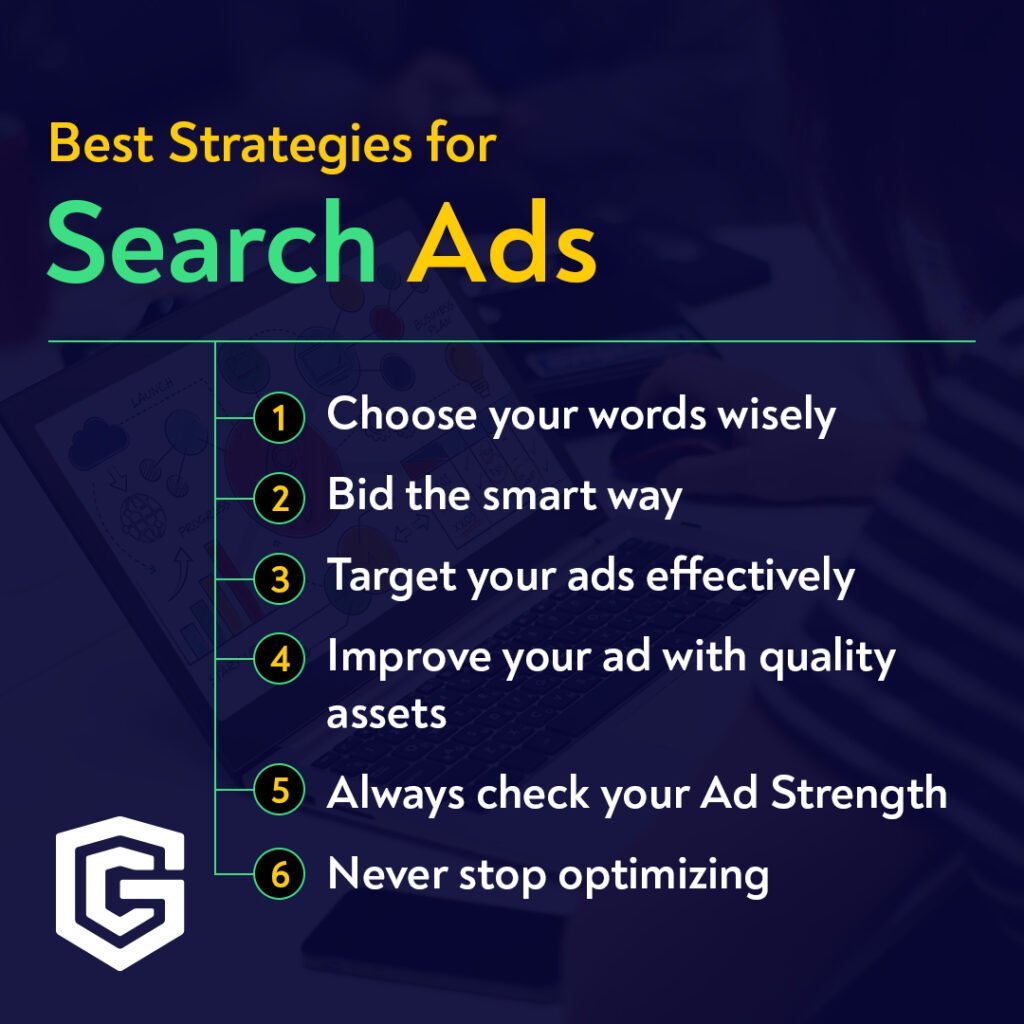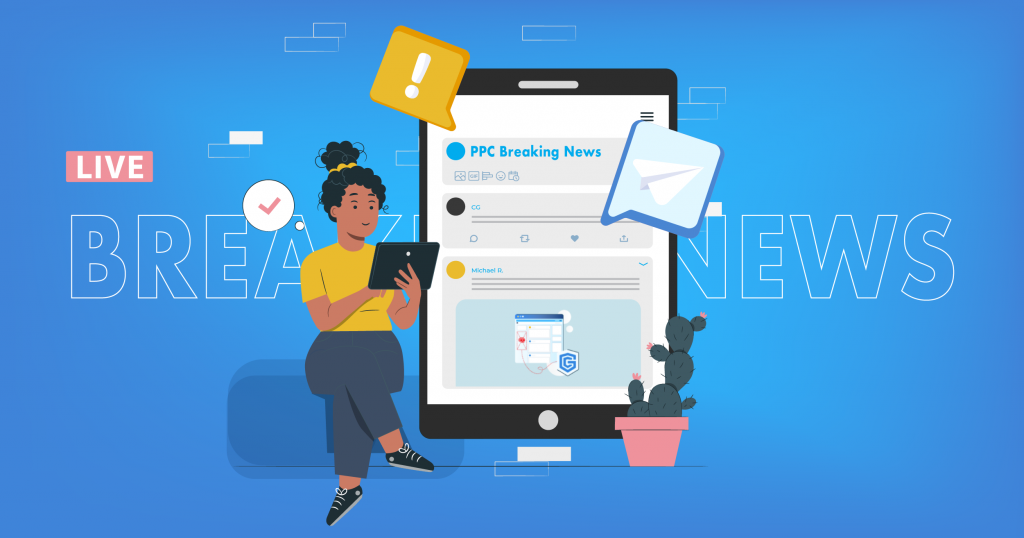Along with the wealth of information Google provides at our fingertips, there is also an enormous opportunity for businesses to reach new customers through Search Ad Campaigns. As the world’s most trusted search engine, Google is not only a useful tool for scouring the web – it is also often the first step in any customer’s journey. Recent data shows that an astounding 99,000 searches happen every second – which is more than 8.5 billion searches a day. But only businesses that take full advantage of Search Ad Campaigns can tap into this vast audience. So what are Search Ads exactly?
Picture this: you’re scrolling through Google searching for a new pair of shoes from a local retailer – and an ad catches your eye. It’s from a brand you’ve never heard of, but it offers affordable yet stylish footwear that matches your exact needs and taste. And to top it off, they’re offering delivery and a discount that you just can’t pass up. This is the power of Search Ads in action.
However, with a high volume of search results, it can be challenging for businesses to stand out from the crowd. That’s why it’s essential to understand how Search Ads work and how to best utilize them. In this guide, we will be taking a deep dive into the key benefits of Google Search Ads, the different ad types available, and today’s best strategies for creating Search Ad campaigns that will drive real conversions.

What are the benefits of Search Ads?
1. Intent-based marketing
Search Ads are particularly useful for advertisers as they offer a way to target potential customers who are actively searching Google for products or services related to their business. This is known as intent-based marketing. By bidding on specific keywords or search terms, advertisers can ensure that their ads are shown to relevant audiences, increasing the chances of clicks and conversions.
2. You choose your objective
Search Ads offer a range of other objectives beyond getting traffic to your website. These objectives include generating leads, sales, phone calls, and even in-person visits. Depending on your business model, you can choose the objective that aligns best with your goals and allocate your budget accordingly.
3. Target your exact audience
Another significant advantage of paid Search Ads is their ability to target your ideal audience. Unlike traditional advertising, which aims to reach as many people as possible, Search Ads allow for more fine-tuned targeting. You can target potential customers based on demographics, interests, purchase intent, website signals, and remarketing data, among other factors. This level of precision enables you to reach the most relevant audience possible, thereby maximizing your chances of converting them into paying customers.
4. Extensive reach
Google Search Ads have the unique ability to appear across a diverse range of platforms and websites within the Google Search Network. Advertisers can choose to display their ads at the top, bottom, or next to the search results on Google’s search engine, as well as on Google Play, Google Maps, and the Shopping tab on Google. In addition to these channels, Google Search Ads also have the potential to reach millions of potential customers through Google’s extensive network of search partners, which includes thousands of other websites. With such widespread visibility, Google Search Ads provide advertisers with unparalleled opportunities to target their ideal audience and drive conversions.
5. Flexible budget options
Finally, with flexible budget options, Search Ads offer a level of scalability that is difficult to achieve with other advertising channels. As your business grows, you can increase your budget to reach more potential customers and drive more conversions. And if you need to tighten your budget for any reason, you can adjust your spending accordingly without having to commit to a long-term advertising contract. You can also track key metrics like impressions, clicks, and conversions to see exactly how your budget is being spent and what kind of return you’re getting on your investment.
Types of Search Ads
Now that we’ve discussed the key benefits of Search Ads in general, let’s take a closer look at the unique types of Search Ads advertisers can choose from, and what marketing goals they are ideal for:
Text ads
Text ads are the most common type of Google search ad. They appear as simple, text-based ads above or below the search results. Advertisers can include a headline, a description, and a display URL. Text ads are highly customizable, so advertisers can tailor their messaging to their target audience. They can also include ad extensions like call buttons, location information, and more to enhance their ad’s visibility and provide additional value to potential customers.
Important note: As of June 30, 2022, advertisers are not be able to create or edit expanded text ads. However, existing expanded text ads will continue to serve, and advertisers can pause, resume, or remove them as needed. Google recommends transitioning to responsive Search Ads, which allow for more flexibility and better ad performance.
- Responsive Search Ads
Responsive Search Ads are a newer type of ad that allows advertisers to provide multiple headlines and descriptions. Google then mixes and matches these components to create different ad variations, testing different combinations to see which ones perform best. Responsive Search Ads are a great option for advertisers who want to save time on ad creation and testing, as well as those who want to maximize their ad’s potential by testing different messages and variations.
- Call-only Search Ads
Call-only ads are designed to encourage phone calls from potential customers. They appear on mobile devices and only feature a phone number and a call button. These ads are a great option for businesses that rely heavily on phone calls, such as service providers, as they can generate leads and conversions directly from the ad.
- Dynamic Search Ads
Dynamic Search Ads automatically generate ads based on the content of a website. Advertisers provide a list of landing pages on their site, and Google creates ads that match search queries with relevant content from those pages. Dynamic Search Ads are a great option for businesses with large and constantly changing inventories or for those who want to save time on ad creation and testing.
- Shopping Ads
Shopping Ads are a type of search ad that includes product information such as an image, price, and product name within the user’s search result. These ads are designed for e-commerce retailers and can appear on the Google Shopping tab, as well as alongside all other Google search results. These ads can be highly effective for driving conversions and sales as they allow potential customers to see products and prices upfront and make an informed purchase decision immediately.

Best strategies for Search Ads
Creating truly effective Search Ads requires careful planning and attention to detail. After setting up your Search Ads campaign (which you can find detailed instructions for here), the following strategies will help make them more effective:
1. Choose your words wisely
The truth is simple: ads that closely match a user’s search query – and grab their attention with compelling copy – are more likely to generate engagement from them. That is why it is crucial to deliver the right messaging for the right search query. Advertisers should always craft messaging that focuses on user benefits, avoid generic language, use specific calls to action, and ensure their headline and description’s messaging aligns with their choice of keywords.
Your headline is the first thing people see when they encounter a Search Ad, so using a strong headline is vital. And by trying out different unique headlines and descriptions, such as headlines of varying lengths, you allow Google’s ad platform to assemble more ad combinations when displaying your ads.
Pro tip: If you don’t have a lot of time on your hands (like most marketers), remember that you can use Dynamic Search Ads to automatically generate headlines for you. Dynamic Search Ads are an excellent option for advertisers who have a sizeable inventory or a well-established website. The headlines and landing pages for Dynamic Search Ads are generated using your website’s content, ensuring that your ads remain relevant and saving you time in the process. Simply add a creative description and you’re good to go.
2. Bid the smart way
Smart Bidding is a very powerful tool that removes the burden of manually setting bids to meet your performance goals. Unlike Manual Cost-Per-Click (CPC) bidding, where you have to manually update bids for specific ad groups or keywords, Smart Bidding uses advanced machine learning to determine the best bid for every ad auction automatically. Smart Bidding also offers bid strategy reports that provide an in-depth analysis of your bidding performance, allowing you to evaluate the effectiveness of your bidding strategies. Here are the different types of bidding strategies (Smart Bidding) that you should know about:
- Target CPA (Cost-Per-Action) bidding is aimed purely at getting the highest number of conversions for an ad, and you can specify the average cost you want to pay for each conversion. When a user performs a search that matches an advertiser’s keywords, Google Ads uses the Target CPA to set a bid in real time based on the probability of conversion.
- Target Return On Ad Spend (ROAS) is designed to automatically optimize bids at auction time based on the likelihood of a search generating a high-value conversion. This means that if the bid strategy determines that a user search has a high probability of resulting in a valuable conversion, it will bid higher on that search. Conversely, if the search is deemed unlikely to generate a high-value conversion, the bid will be lower. This allows for tailored bids for each auction, and bids are automatically optimized to maximize Return on Investment (ROI).
- Maximize Conversions is a highly recommended bidding strategy as it automatically optimizes bids for your ad each time it’s eligible to appear. By analyzing historical campaign data and contextual signals at auction time, Maximize Conversions uses advanced machine learning to find the most cost-effective strategy that will lead to the highest number of conversions.
- Maximize Conversion Value **prioritizes generating the highest possible value of conversions for a given budget. This is different from Maximize Conversions, which focuses on achieving the highest possible number of conversions for a given budget – without taking into account the value of each conversion.
Important note: Setting up conversion tracking allows you to monitor user actions, such as sales, leads, phone calls, or website visits, after interacting with your ad. Conversion tracking is therefore vital in determining the effectiveness of your ads – and it is also a requirement to use Smart Bidding. Without conversion tracking, you can still use automated bidding with the maximize clicks strategy.
3. Target your ads effectively
Effective search ad targeting is crucial for businesses to reach their potential customers without spending their ad budget ineffectively. One common mistake advertisers make, for example, is targeting only a small city or a few keywords, which can greatly limit the reach of their ads. Conversely, targeting too large an area can lead to irrelevant traffic on their website. When it comes to targeting, advertisers can avoid such pitfalls by following these three best practices:
- Location targeting should be done based on where customers are – rather than just where the business is located. For instance, an e-commerce website should target all the locations where it ships its products, rather than just where the business is located. Advertisers can adjust their location targeting settings at any time to optimize their ad reach.
- Building a good keyword list is another crucial aspect of expanding targeting for Search Ads. Advertisers should invest time and effort in selecting relevant keywords that their customers might use to search for their products or services. Starting with the main categories of the business, advertisers can then use tools like Keyword Planner to expand their keyword list with related terms and product names.
- Creating separate ad groups for different products and categories can further improve the targeting of Search Ads. Ad groups should contain ads that are directly related to the keywords in that group. For instance, an online bicycle shop can create separate ad groups for children’s bikes, racing bikes, mountain bikes, road bikes, helmets, and bike locks, with specific keywords related to each product in the respective ad groups.
4. Improve your ad with quality assets
Implementing assets such as images, site links, pricing, a phone number, or a lead form can make your Search Ads a lot more engaging and provide helpful information about your business. Always try to enable all the asset types that make sense for your business.
Pro tip: Google recommends adding at least four different asset types to your Search Ad campaigns to improve your ad quality and, as a result, the click-through rate.
5. Always check your Ad Strength
Google’s Ad Strength feature can provide valuable feedback on how well your ad follows Google’s best practices for optimal performance. Improving your Search Ads until they fall within the Good or Excellent Ad Strength group can be a big difference-maker. In fact, Search Ads that have an Excellent Ad Strength rating receive an average of 9% more clicks and conversions compared to those with a Poor rating.
To improve Ad Strength, here are some common call-to-action recommendations:
- Maximize the number of ad combinations by adding more headlines and descriptions. The ad creation process provides asset suggestions to help you write high-performing headlines and descriptions, which you can accept, edit, or use as inspiration.
- Make your headlines and descriptions unique and describe what you are selling, along with your unique selling points to appeal to different customers. Avoid using repetitive words or phrases to generate more combinations.
- Reduce pinning to show more combinations of headlines and descriptions. If you must use pinning, consider having multiple unique assets pinned to the same position.
- Improve your ad’s relevance by including keywords from your ad group’s popular keywords in your headlines and descriptions.
Pro tip: You can use keyword insertion to automatically update your ads with the keywords in your ad group, which will keep your ads relevant to exactly what users are searching for.
6. Never stop optimizing
Getting great results from an effective Search Ad campaign doesn’t mean you should stop there. Testing and optimizing creative messages are essential for continually improving Search Ad performance. Trying out different ad variations can be used to test and iterate creative messages, and success should be evaluated based on incremental impressions, clicks, and conversions.
A great analytics tool worth mentioning is Google’s Report Editor. It allows you to interact with your data by creating multi-dimensional tables and charts. Using a drag-and-drop interface, you can build and modify these tables and charts. You can also use multi-segment analysis to separate your data with greater precision, and custom charts to visualize trends and patterns in your data. Additionally, the tool offers advanced filtering and sorting features that allow you to filter segmented metrics and sort them by multiple columns.
Pro tip: The traditional last-click approach for measuring online advertising success overlooks other customer interactions with ads. Attribution models can give you more control over how much credit each ad interaction gets for your conversions. As a result, you can reach customers earlier in their purchase cycle and gain a more holistic understanding of your customer’s click journey.
Keep your search ad campaigns protected
As pervasive and powerful as Google Search Ads may be, they are still not immune to wasteful or fraudulent traffic. Click fraud refers to clicks on ads with malicious intent. This can come from intentional clicks on your ads by competitors, publishers artificially inflating click revenue, or clicks generated by bots. In 2021, more than 42% of all web traffic worldwide was generated by bots – and this is a growing problem every advertiser needs to address.
Thankfully, there are measures businesses can take to safeguard themselves and their ad campaigns from click fraud – and ClickGUARD is the perfect solution. ClickGUARD is a leading Google Ads click fraud protection and prevention software that can detect and prevent illegitimate clicks or wasteful traffic. By essentially acting as a firewall, it identifies and negates the impact of fraudulent activity on your ad campaigns, allowing you to maximize the effectiveness of your advertising budget.
Our latest version comes with fully automated features, improved reporting, a more intuitive user experience, and Facebook Ad protection, making it accessible to any business or marketer looking to keep their search ad campaigns protected.
With a free trial available for everyone, there’s no reason not to give ClickGUARD a try and see the results for yourself.
FAQ
What are the benefits of Search Ads?
Beyond having extensive reach, Search Ads target customers who are actively searching for related products or services. They also allow advertisers to choose a campaign objective that aligns with their business goals, target their exact audience, and take advantage of flexible budget options.
What are the different types of Search Ads?
There are five types of Search Ads: text ads, responsive Search Ads, call-only Search Ads, dynamic Search Ads, and Shopping Ads. Each type of search ad has its unique strengths and weaknesses, making them better suited for different advertising objectives.
What are the best bidding strategies for Search Ads?
Unlike Manual CPC bidding, where you must manually update bids for specific ad groups or keywords, Smart Bidding uses machine learning to automatically optimize bids for every ad auction, making it a highly recommended option for any ad campaign.
How can you target Search Ads more effectively?
Advertisers should consider location targeting based on where their customers are, invest time in building a relevant keyword list, and create separate ad groups for different products or categories.
What is the best way to keep your search ad campaigns protected?
By essentially acting as a firewall that shields your ads, ClickGUARD can detect and prevent illegitimate clicks or wasteful traffic to keep your search ad campaigns protected.



